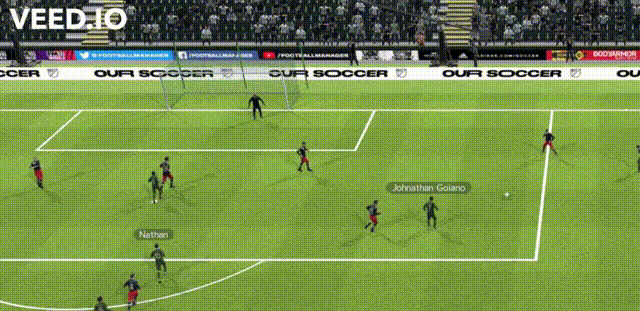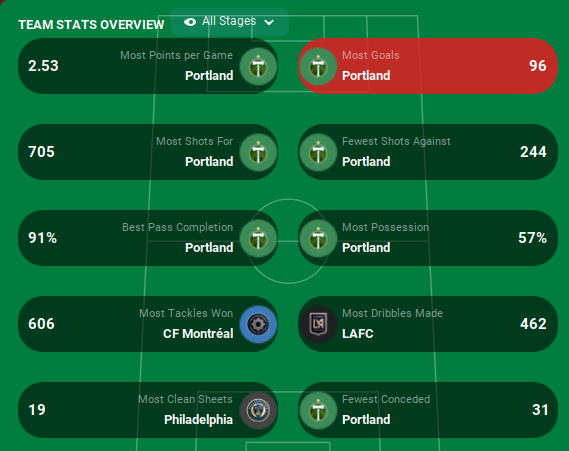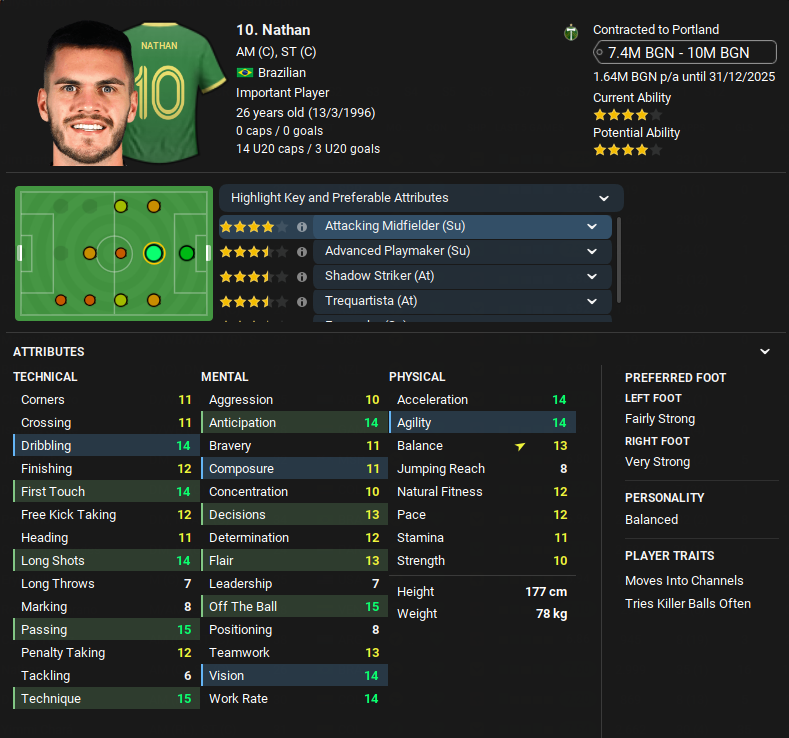Do you want outrageous goals and Samba soccer like this? Read on to find out how I made the Best Football Manager 22 Tactic for MLS Ever!!!
Sensational Samba Soccer
The Best Football Manager 22 Tactic for MLS Ever!!!
Record breakers
How can I be so sure this is the best football manager 22 tactic for MLS? A quick look at the stats over the course of our second season in MLS paints a picture of an almost “perfect” tactic. We completely dominated the MLS Supporters Shield, in fact we were invincible (almost). Combining high levels of attacking efficiency and possession, whilst balancing this with one of the best defensive records on the entire continent. We scored the most goals (96), took the most shots (705), conceded the fewest amount of shots (244), had the best pass completion (91%), the highest average possession (57%), and we conceded the fewest goals (31) despite having a below average goalkeeper.
We actually broke the following all time MLS records using our amazing tactic.
MLS record number of points (91)
MLS record number of goals scored (96)
MLS record number of wins (30)
MLS record low defeats (1)
MLS record number of matches without losing (25)
The Best Football Manager 22 Tactic for MLS Ever!!!
Formation and Instructions
Defense
Our tactic is listed in Football Manager as a 5-2-1-2 WB. It is important to remember that the tactics screen in FM is showing you how your side lines up in defense. It is the roles and duties that dictate where your players end up when you are in attack. My 5-2-1-2 is pretty attacking as we are leaving three players up the pitch when out of possession.
Sensational Samba Soccer
Defensively we start with a standard Goalkeeper on defend, I don’t need anything fancy from him other than stopping the ball going into our goal and kicking it to our center backs. Our back three features the new wide center back role on defend, a standard center back on cover, and a ball playing defender on defend.
Our wide center back on defend can offer some cover in transition to the right side wing back who is on attack, which gives him the freedom to get to the byline when possession has been built up. Our left side is a little more conservative with a wing back on support beside the ball playing defender. As you can see in the image below, Abdul-Salaam (WCB) moves slightly wider and further forward than a normal center back. This gives us some cover on the flank for the attacking wing back, but it also allows us to create an overload on the right side. If our attacking wing back runs into trouble the wide center back is always available to recycle possession and keep the attack moving. The inset image shows assist locations for our opposition, you can see that we do not concede anymore goals from the right side, than we do from the left, despite using an attacking wing back on the right side. Our left center back of the three is a Ball Playing Defender who likes to switch play to the opposite flank, by giving him the freedom to play more risky passes I am content for him to play longer balls to the attacking right wing back. For this to be effective, however, he will need good vision, decisions, passing and technique (I used Rivaldo Coetzee in this position). My left wing back is on support, and he will commonly be involved in the build up play with the midfielders, helping us to retain possession, and providing cover in defensive transitions.
Image showing the wider, more advanced, positioning of our WCB when we are attacking.
Midfield
In Midfield we have a box to box midfielder on the left side. He will link up with our supporting left wing back in build up, before making runs into the opposition box as the play progresses forwards. You need a player in here that you can rely on to get up and down the pitch for the whole ninety minutes. A few desirable attacking traits would also be welcome such as “arrives late in opposition box” or “gets forward whenever possible”.
His partner in center midfield is a standard center midfielder on support. During defensive transitions, with this tactic, it is not uncommon for us to have five or six players in the opposition’s final third. With this in mind it is important to have someone occupying the space in midfield in case the opposition launches a counter attack, or makes a clearance. Having the right player in here can see you launch wave after wave of attacks, rather than hiding behind the sofa every time the opposition clear the ball. I found that a center midfielder on support could also get caught ahead of the ball, especially one with attacking traits, so I felt I needed to modify the role or potentially use a different role entirely. I ruled out the center midfielder on defend as being too conservative in positioning and in possession. I used a deep lying playmaker initially, but our play became too predictable by going through one single player all the time. So, I decided to add some player instructions to my center midfielder on support to get the best of both roles.
Take more risks - As he will often have four or five runners ahead of him, I want him to have the freedom to play a risky pass.
Shoot Less Often - As above he will generally have runners ahead of him so I don’t want him spaffing shots over all the time.
Hold Position - This is an important one, I need him to occupy the space outside the penalty area when we are attacking, especially given the right wing back is on attack. This will allow us to recover the ball when the opposition clear it, or he can tackle/harass the opposition when they counter us. I often used players well suited to being a ball winning midfielder in this role to get even more protection when the situation demanded it. If you find yourself chasing a game this is one position that can be made more attacking to find that goal you need!
Player Instructions can make a big difference
Attacking Trio
This is where a lot of the magic Samba Soccer happens, this tactic is set up for these three to cause havoc in the opposition’s final third. The variety of our movement continually caught opposition defenses out. Our number 10 is a standard attacking midfielder on attack and he plays behind a deep lying forward on support and an advanced forward. The movement of these three roles is critical and took some consideration initially. The advanced forward will do his usual thing, leading the line and being the focal point of our attacking play. His strike partner is a deep lying forward on support, he will often drop deep into midfield dragging defenders with him creating space for our attacking midfielder on attack to exploit, especially as his role requires him to “get further forward”.
As always it is an added bonus if you can get players with traits that complement these roles. If, during a game I felt we weren’t getting the space we needed I would add “roam from position” to my attacking midfielder and very often this subtle change was enough to unlock a steadfast defense. The three players I had in these positions played them perfectly.
Nathan (Attacking Midfielder) Has all the technical quality required to play as a Number 10 along with the traits “moves into channels” and “tries killer balls often”. Both of these helped add variety to our attacking play and kept opposition defenses guessing.
Goiano (Deep Lying Forward) A truly remarkable find and a quality forward option in many different roles. I ended up using him in the deep lying forward role due to his trait of “comes deep to get the ball”. The interplay, and link up, between Goiano and Nathan gave defenders difficult decisions to make throughout the 90 minutes.
Chará (Advanced Forward) Quick, two footed, with good off the ball and dribbling, Yimmi Chará scored an amazing 36 goals in the second season (a Timbers record) averaging one goal every 76 minutes!
The video below shows the “perfect” Samba Soccer Goal. It was taken from our 5-1 destruction of @FMGrasshopper’s Inter Miami. It starts with us ‘playing out from the back’. Goalkeeper Steve Clark plays it short to our ball playing center back. He then plays an immediate forward pass to Box to Box Midfielder, Paulinho, who finds our wing back on support, Abdul Salaam in this game. We have an overload in midfield as Nathan has dropped fairly deep, Paulinho finds Paredes who is our modified center Midfielder on support. Johnathan Goiano, the deep lying forward, comes deep and drags an Inter Miami center back with him. Advanced Forward Yimmi Chará immediately sees the space left in behind and makes a run. Paredes has ‘take more risks’ as a player instruction, spots Chará’s run and plays an inch perfect pass into his path. Yimmi Chará doesn’t miss chances like that - Perfect SAMBA!
Team Instructions
The FM tactic module rather handily breaks up team instructions into three phases of play. Over the last few editions approaching tactic creation in this manner has helped my own gameplay immensely. I will now take each phase in turn and explain the reasoning behind the selections I have made.
In possession
In possession
When in possession our tactic aims to retain the ball, building up slowly from the back to give our wing backs time to advance to provide overloads, if required, in the wide attacking areas. If we can break teams down through the middle we will but if we can not, we can easily switch the play to our wing backs to keep attacks going, or they can play dangerous balls into the box. Both my wing backs provided record number of assists in season two.
To achieve this our attacking width is set to fairly narrow, we want to keep the ball, so having players closer together aids this, I also don’t want to use the flanks unless we need to as we only have one player out there. We have superiority of numbers in many central areas so our primary focus should be there. I did try using focus the play through the middle but this made us too easy to defend against, hence it is not selected.
We play out from the back, and keep passes short to give our players time to advance, and to invite the opposition onto us a little, to give our runners from deep (box to box midfielder and attacking midfielder) space to attack the opposition in behind when we arrive in the final third. Remember we also have a ball playing defender who has the licence to play more risky passes should he wish, this hopefully stops us being too conservative with our possession in defense. Creative freedom can also be toggled up and down depending on the game situation.
In Transition
In Transition
Defensive transitions have been the most challenging aspect of the tactic to get right.
As we have four or five players in advanced areas when attacks break down, It makes sense to counter press the opposition. If we lose the ball the forward players are already in position to harass the opposition, and potentially recover the ball before a counter even starts. Using this tactic we often see the opposition defense “hoof” the ball clear, which plays into our hands as we have the added security of three strong center backs, who are very often only up against a single lone forward.
I would like to have the option to remove certain players from the counter press, in this instance our central midfielder on support. I’d much rather he regrouped rather than followed everyone else into the press. This is an area of the tactic I pay attention to every game and if the central midfielder isn’t able to regain his position quickly and it is causing me problems I may switch his role, or remove the counter press.
We have set nice and simple instructions for our Goalkeeper. He is asked to take short kicks to our center backs who will build the play up slowly.
Out of possession
When we don’t have the ball I want us to remain compact and squeeze the playable area for our opposition. I believe this give us the best opportunity to regain possession quickly and keep the opposition as far from our defensive third as possible. To do this I have set a higher defensive line but have kept our line of engagement as standard. Our attacking play relies on having space to move into, having a high line of engagement would reduce this space.
I do keep these under constant review and the defensive line is very often moved back to standard if I observe the opposing attackers getting in behind our center backs. The press is set to more often, this is for similar reasons to the counter press, I want to win the ball back quickly or harass the opposition into making a hurried clearance so our three center backs can regain the ball. We also prevent short GK distribution to once again encourage a long ball from the back which is ‘'meat and drink’ to our aerially superior center backs. So while we do press the opposition this isn’t gegenpress helter skelter hackz.
Defensive actions show our main press doesn’t start until the halfway line.
La Copa Club World Cup
Before we wrap up I should also mention I have used this tactic in Latte Quarterly’s La Copa Club World Cup. If you don’t know that that is, it is a tournament showcasing the clubs you love to read about facing off in Football Manager 2022 Versus Mode. This edition the entrants where,
Group A;
Fortuna Düsseldorf (@fm_athlete)
RCD Mallorca (@fmadventurebot)
Newcastle United (@MaddFM_)
Portland Timbers (@FMEadster)
Group B;
Inter Miami CF (@FM_Grasshopper)
Southampton FC (@FM_Samo)
Ternana Calcio (@youthintake)
Warta Poznań (@FMRensie)
Somehow, little Portland despite being curtailed by the MLS salary cap, managed to win Group A and qualified for the semi-finals to face Ternana Calcio (@youthintake) . An emphatic 4-1 win (AET) further illustrates the power of this tactic (as well as a few lucky bounces!).
We will face either Southampton FC (@FM_Samo) or Newcastle United (@MaddFM_) in the final. If you want to know more about La Copa or Latte Quarterly please follow them on twitter or visit their homepage here.
On final thing before I go. As any good tactic tester should, I ran a season long sim as Bayern Munich. I think it is clear this is the best Football Manager Tactic, Ever!! +maybe.
As ever thanks for making it this far, the title of this post is tongue-in-cheek but the words within the post are a genuine explanation of how my Portland Timbers side played in season two of the MLS save. I thoroughly enjoyed the football it produced, let me know if you try it.
Over and out
FMEadster!










